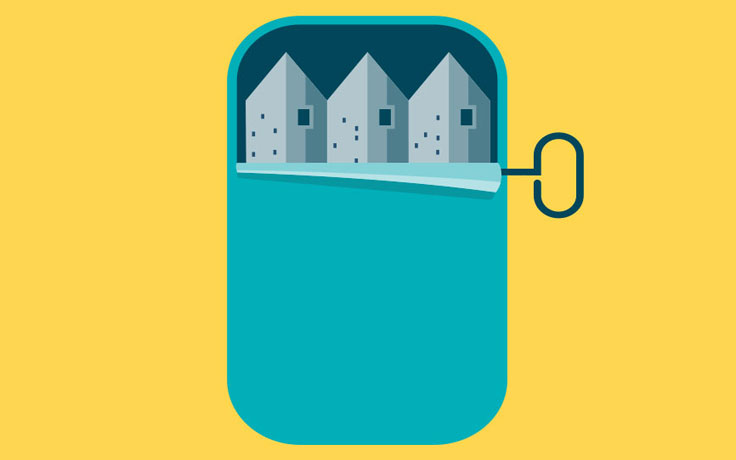AT A TIME WHEN THE NATION IS WRESTLING with a severe housing shortage, politicians, policymakers and communities are scrambling for responses. But Dana Cuff sees solutions hiding in plain sight, in nearly every neighborhood.
Cuff, a professor of architecture/urban design and urban planning at UCLA, is exploring ways to add affordable housing in places like backyards, public schools, college campuses and a variety of underused spaces that dot our cities.
“We have lots of opportunities to add housing if we think more creatively,” said Cuff, who is also the founding director of cityLAB, a design-research center at UCLA that seeks ways to make housing available to a wide spectrum of Californians. “This is the moment when design really matters in terms of trying to figure out how to solve parts of the housing crisis.”
As wages remain stagnant and housing prices increase, the need for affordable housing across the United States has hit emergency levels. It is a crisis that contributes significantly to economic inequality. A survey by ATTOM Data Solutions, a property data company, has found that home prices are rising faster than wages in 80% of U.S. markets.
According to the U.S. Department of Housing and Urban Development, an estimated 12 million renter and homeowner households nationwide now pay more than 50% of their annual income for housing. This is an alarming figure, considering that HUD defines anyone paying at least 30% of their income on housing as “cost burdened” — a threshold that can make it difficult to buy food, clothing, transportation, medical care and other necessities.
To address the problem, California would need to build 2.5 million new housing units by 2025 to accommodate future growth as well as to address its backlog of past unmet needs, according to a 2018 University of Southern California analysis. Cities desperate for answers are looking at subsidies, increased density, zoning changes, adaptive reuse of older buildings and other options.
“In the past, it might be that you could pay $300,000 for a house when your income was $50,000 and you could still pay your monthly mortgage without spending more than 30% of your monthly income. But now that’s not true,” Cuff said in a telephone interview. “The cost of housing has gone up across California — particularly in the cities — and wages have stagnated. The difference between what we earn and what we pay for housing has gotten greater.”
The crisis, Cuff and other researchers say, calls for real-life experimentation to determine what will work to ease the emergency and what won’t.
The rent is too -damn high
ONE OF THREE CALIFORNIANS pay more than half their income in rent – and the percentage is even higher in the Los Angeles area.
California Senate Bill 50, authored by Sen. Scott Wiener (D-San Francisco), was a bold and aggressive attempt to address the housing crunch. The bill, also known as the More HOMES (Housing, Opportunity, Mobility, Equity and Stability) Act, called for overriding low-density zoning restrictions to permit more mid-rise housing to be built near job centers and public transportation. It would have allowed fourplexes in most single-family neighborhoods, with requirements for low-income units.
Opposition was especially intense from high-income residents able to fend off development by pressuring their local elected officials, as well as from underserved, often lower-income communities fearful of being displaced by the newly gentrified areas. Wiener made numerous changes to the bill, including provisions that would have given cities two years to come up with their own plans to meet construction targets.
But in February, the legislation was voted down.
Although Gov. Gavin Newsom did not formally endorse SB 50, its defeat was seen as a setback to his ambitious goal for the state to build 3.5 million homes by 2025. “Doing nothing is no longer an option,” Newsom said in his State of the State address in February. “It’s time for California to say yes to housing. We cannot wait.”
Many agree, but much of the problem is with one-size-fits-all remedies.
“People say, ‘OK, you say we need to build more housing so that housing will be affordable,’ but how much housing do we need to build? There are a lot of moving parts in that question,” said Michael Lens, an associate professor of urban planning and public policy. “What we do know is if you keep pushing the number toward zero, more and more people are going to suffer.”
Alternatives to sprawl
A 2001 BROOKINGS INSTITUTION and USC report found that “sprawl has hit the wall” in the Los Angeles region, which has limited additional land on which to grow and few additional resources left to consume.
“Our old solution in California — and especially in Los Angeles — of just moving farther out is no longer viable,” said Cuff, who holds a bachelor’s degree in design and psychology from UC Santa Cruz and a doctorate in architecture from UC Berkeley. “It’s too far to drive — we have more super-commutes than any other region in the country, meaning people who drive more than 90 minutes each way to work. People have already moved out as far as they’re going to get. And be- cause of the housing crisis, now those areas have become very expensive.”
In places where “sprawl has hit the wall,” the only option is to build more housing within existing boundaries, ultimately increasing density. “People think density is just a bad word,” she said. “There’s land available. You have to rethink the planning context and the building — what it means to build a new home.”
Cuff has experience turning creative thought into action. She co-wrote a bill with California Assemblyman Richard Bloom (D-Santa Monica) making it easier for homeowners to build accessory dwelling units (ADUs), also known as “granny flats.” Los Angeles alone has more than a half-million single-family lots. If only 10% of those property owners build ADUs, 50,000 new units could be added to the housing inventory. Bloom’s bill and a companion bill from Sen. Bob Wieckowski (D-Fremont) went into effect in 2017.
Although not all ADUs are “affordable” housing, data show that about one-third are below market rate, said Cuff, who lives in an ADU in Santa Monica.
“We worked for 10 years to pass … [ADUs] at the local level, and every time we had a near-majority, some city council member would get pressure from a neighbor and they would turn their vote, and we would lose again — and it would be a single (resident) neighbor, usually, that got in the way,” Cuff said. “That isn’t local interest, that’s single interest. And now we see it’s gotten to such a heightened problem that no neighborhood wants to make supportive housing.”
The “not in my backyard” syndrome is common, and it is the reason that some advocates of “up-zoning” push for measures like SB 50, which would take such decisions out of the hands of local officials.
“Our city council and our mayor are just like everybody else’s city council and mayor in that they end up having to listen to a tiny minority of homeowners that say no to everything,” said Lens, the associate professor of urban planning and public policy. “If they didn’t have that responsibility and that control over local land use to that extent, that minority wouldn’t have the power to say no.”
Not all communities are obstructionist. For example, many community groups along Los Angeles’ Crenshaw corridor opposed Wiener’s legislation because they had already negotiated neighborhood development plans that drew on their input and included more density and afford- ability, says Michael Storper, UCLA distinguished professor of regional and international development in urban planning, who was critical of SB 50.
“That’s a real lesson of what we just went through with SB 50: These communities need to be consulted, and they need to be given opportunities to be part of the solution,” he said. “The mandated affordability in SB 50 was lower than they’d already negotiated — they already had a better deal. This is what you might call bottom-up policy, not top-down policy.”
Storper argues that any legislation must include clarity about affordability, as well as a clear roadmap to who is paying the costs. And, he says, simply building more units won’t be enough to end the housing crisis.
“The equation of more equals cheaper is wrong,” he said. “You could carpet San Francisco with skyscrapers, and there’s a decent chance that it would actually get more exclusionary and not less.”
Affordability amid extravagance
CREATING AFFORDABLE HOUSING CAN BE ANYTHING but affordable. In California, it requires an average of $500,000 to $600,000 to construct each unit. Architects, developers and builders have been experimenting with new forms of manufacturing, including mass-produced housing, 3-D printed houses and other new technologies to bring down costs.
Cuff and cityLAB are exploring ways to take advantage of excess or underused land around public school buildings, community colleges and state universities to provide afford- able housing for teachers and staff or for commuting college students.
“There are about 11,000 public school campuses in the state of California,” Cuff said, “and some of those — not all of them, but some of them — would be better if they had affordable housing built on them, because it’s publicly owned land, and we could guarantee that [the housing] was going to stay affordable.”
Potential solutions include infill projects, building above parking lots or on vacant land, adding height to existing buildings and renovating abandoned buildings — without affecting green space, playing fields or playground areas.
Los Angeles Unified School District has already experimented with affordable workforce housing, such as the 90-unit Sage Park Apartments on the north side of the Gardena High School campus. The workforce housing site in Glassell Park includes an early education center. Such innovations serve entire communities, Cuff said, and can help overcome political resistance to the affordable housing.
“With school-lands housing, the beauty is similar to the backyard ADUs — you don’t have to buy the land to build housing; you already own it,” she said. “In the case of schoolyards, it’s owned by the public, and it’s already dedicated to public use.”
Los Angeles Mayor Eric Garcetti has set a goal of permitting 100,000 new housing units by next year, ensuring that at least 15,000 affordable units are built or preserved for low-income households. Many argue that subsidies or setting aside a percentage of units for lower-income residents are keys to guaranteeing that affordable housing is built.
“New housing has always been something that is out of reach for lower-income households unless there are massive subsidies,” said Lens, who sits on the citizens oversight committee for Proposition HHH, a $1.2 billion bond measure to more than triple the annual production of supportive housing and build 10,000 units for the homeless. “If we think new housing is important, and that housing is only going to people who can pay quite a lot, let’s make sure we mandate some of these new units to be set aside for other people.”
Whither public housing?
ACCORDING TO A REPORT by the state Legislative Analyst’s Office, an average California home costs 2.5 times the national average, while California’s average monthly rent is about 50% higher than rent in the rest of the country.
“Right now, to think about affordability, we need a very decisive combination of affordability set-asides and have to figure out who pays for them,” said Storper. “I believe we need to reactivate public housing in America, especially for the lower 30% to 40%. There isn’t any way for the market to produce housing that those people can afford with the kinds of incomes and jobs they have. Period.”
Public housing was popular in the 1940, ’50s and ’60s, when high-density, high-rise buildings were constructed in major cities across the country. While many such complexes still exist, they largely fell out of favor in the 1970s and were replaced by housing vouchers, which allowed recipients a choice of where to live. Public hous- ing began to be viewed as crime-infested and dangerous, an image it has not been able to shake.
Lens has done extensive research into public housing. It “works around the world,” he said. “We just don’t spend on it like other countries do. It’s a federal program, so it’s underfunded everywhere in the U.S. Upkeep has been a problem for a very long time.”
Nonetheless, it is an option many American cities are starting to revisit. In Los Angeles, Councilman Mike Bonin has proposed looking into public housing — rental property owned and managed by the government, by nonprofit organizations or a combination of the two. He has called for a study of housing models in Austria, Sweden, Finland and Singapore.
Lessons also can be found in Japan, Cuff said. “There’s no minimum house site in some parts of Japan. They let the market determine it, and that means that very small and tall houses get built in a city like Tokyo.
“One of the things we just have to look for is how to use the land that’s so vast in Los Angeles more intensively,” she said. “The housing crisis is so vast that it’s going to take, in my mind, 50, 100 different solutions. Every possible solution has to be exploited.”

























